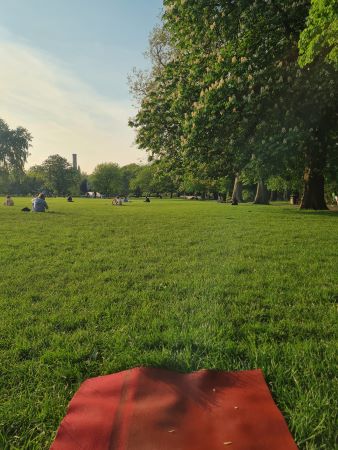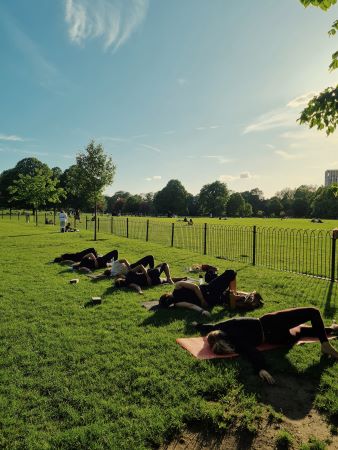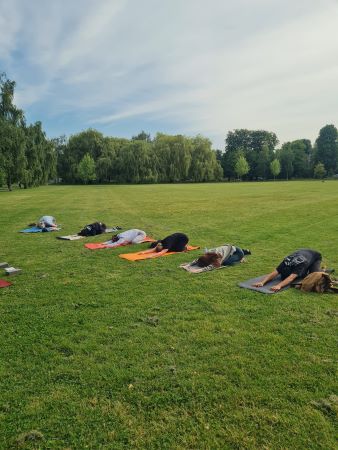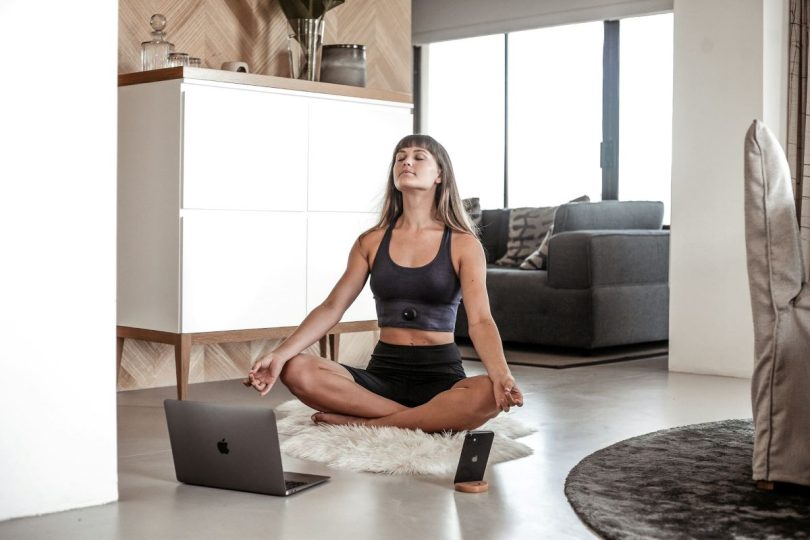My yoga journey began with free YouTube videos that I followed at home, such as Yoga with Adriene and Fightmaster Yoga. These online teachers provided me with a consistent and accessible practice, which allowed me to build confidence, hone my form, and deepen my understanding of the body.

As my practice developed, I wanted to try studio classes but felt a little intimidated by the “yoga girl aesthetic” of coordinated yoga outfits, flexible limbs, and limited diversity. This is where community classes can fill a gap.
Community yoga classes are designed to be accessible to everyone in the local community.
They are typically open-access, tailored to all abilities (beginner-friendly), and offered at a reduced cost or for free. These classes are sometimes offered by yoga studios as an initiative to give back to their local community, or by local councils and GPs to provide health and wellbeing activities.
A common misconception is that community classes are inferior to other studio classes. However, they hold great potential to benefit individuals, local businesses, and the wider community.
The Benefits of Community Classes to the Student
Community classes increase accessibility and promote inclusivity in yoga. For students who are looking to try yoga for the first time, or who don’t feel comfortable in a studio environment, this is a great way to access in-person classes. It provides them with the opportunity to learn under experienced practitioners, receive feedback, be adjusted in poses to refine their skills, and experience different teaching styles.

Community classes have the potential to inspire new students to deepen their practice, introduce them to new styles of yoga, and promote local businesses. Similar to studio open days or introductory offers, community classes can open the doors of a studio to more potential clients, while also helping build stronger connections with the local community. Knowing that a business is giving back to the community fosters trust and connection.
A particularly important aspect of community classes for me is the accessibility. Similar to my own trepidation about attending studio classes, some students find yoga intimidating and unwelcoming. For others, the cost of studio classes can be a significant barrier to accessing a movement practice that benefits both physical and mental wellbeing.
The Benefits of Community Classes to the Teacher
As a teacher, delivering community classes offers many opportunities. Firstly, teaching an all-abilities, open-access class can be a real challenge. The open-access nature means you are less likely to know your students or have built a relationship with them. They may have varying experience levels and abilities, or different physical or medical conditions. This provides teachers with a great opportunity to develop and strengthen their teaching skills by learning to adapt their classes and gaining more knowledge about different bodies and conditions. Having the freedom to not be tied to a particular type of class on your schedule, community classes can also be a good space to try new styles or teaching methods.
My Experience of Teaching Community Classes
I have been offering community yoga classes for the past three years every summer in the local park. Using a free space like the park keeps costs low, allowing me to offer free or donation-based classes, ensuring financial accessibility.

I find these classes incredibly rewarding. Being outdoors, moving my body, and seeing connections form between my neighbours provide me with such warm energy. Through these classes, my teaching skills have strengthened significantly. I’m much clearer in my directions, more creative with pose modifications, and I have a deeper understanding of different bodies and abilities.
Tips for Offering Community Classes
If you’re thinking about offering community classes, here are a few things I’ve learned along the way:
- Plan for everything. You never know who will turn up or what their ability level will be. Have plenty of modifications prepared, and be ready to adapt or change your flow to suit the class.
- Be patient. Varying experience levels and abilities can make following a flow challenging. You may need to give instructions and demonstrate poses multiple times.
- Check in with your students. To ensure your students are comfortable and getting the most out of class, regularly check in with them. Before class, ask about their experience, ability, and any physical issues or injuries. During class, make sure the group is comfortable and following the flow. After class, ask for feedback to help you improve their experience.
- Don’t be disheartened by no-shows. If you’re providing free or drop-in classes, there is often a lower commitment for students to attend. Don’t be discouraged by smaller classes or no-shows. It’s part of offering flexibility.
- Observe your students’ bodies and expressions. Community classes often attract beginners. They may not have a good understanding of their bodies or be familiar with the poses, and may push themselves even when uncomfortable or out of alignment. Be aware of this and help them find what works best for their bodies.

I believe community classes are hugely important for society. They increase accessibility, which in turn supports inclusivity. In a world where looks and aesthetics can be deterrents, and where more and more people are struggling with their wellbeing and finances, community yoga classes have the potential to heal.
Main – Photo by Angelina Sarycheva on Unsplash



